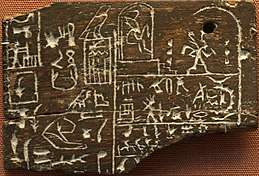Naos (hieroglyph)
| Shrine (Naos)-O18 (O21-rectangular) in hieroglyphs |
|---|
Naos (Greek ναός "temple, shrine") the descriptive name given to an Egyptian hieroglyph (Gardiner O18).

King Den label, Old Kingdom.
The pavilion hieroglyph is a side view of the pharaoh seated, in opposing views, wearing the two separate crowns, the crown of the South, the white crown, and the crown of the North (the Delta), the red crown. The pavilion is composed of two side views of the naos hieroglyph.
The early Old Kingdom labels, for example Pharaoh Den, portrayed him in a side view in his naos shrine. An example of the combined, opposed, view with the two crowns, is the lintel of Senusret II, 12th dynasty, 19th century BC. It shows the naos curved roofs of each half of the pavilion hieroglyph.
A naophoros ("temple-bearer") is a type of statue holding the naos symbol. An example is the Ramesside-era statue of Panehsy, overseer of the treasury.[1] The earliest examples of such statues date to the 18th dynasty.[2]
See also
| Wikimedia Commons has media related to Naos (shrine). |
| Wikimedia Commons has media related to Chapel (hieroglyph). |
References
This article is issued from
Wikipedia.
The text is licensed under Creative Commons - Attribution - Sharealike.
Additional terms may apply for the media files.